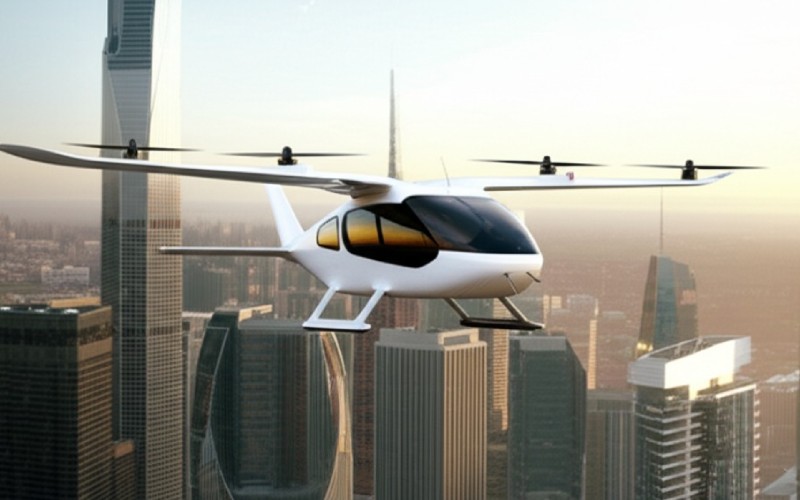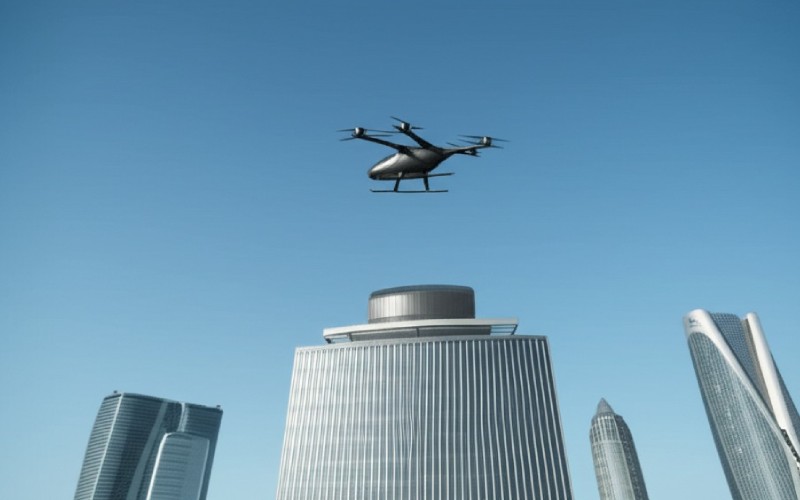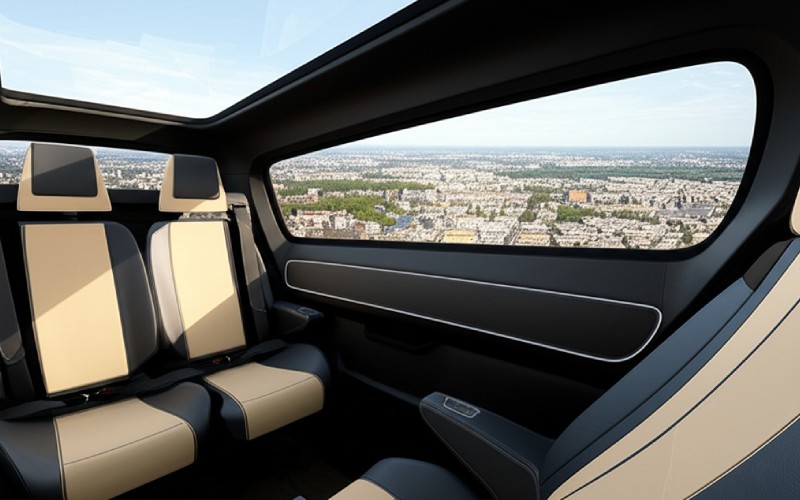Let Sino's Lamination Stacks Empower Your Project!
To speed up your project, you can label Lamination Stacks with details such as tolerance, material, surface finish, whether or not oxidized insulation is required, quantity, and more.

Now, we’re on the edge of a huge change in aviation. Imagine flying over city traffic in a quiet, electric vehicle. This isn’t a dream. It’s the world of electric aircraft and eVTOLs.
This article is your easy-to-read guide to electric vertical flight. We’ll explore what these eVTOL vehicles are and how they work. I’ll explain why they are set to change air travel forever. We will talk about everything from their design to ensuring a safe landing. If you want to understand the next big thing in how we move, this is for you.
Let’s start with the basics. You may hear the term eVTOLs a lot these days. So, what are they? eVTOL stands for electric vertical take-off and landing. Think of an eVTOL aircraft as a mix between a small plane and a helicopter. These innovative aircraft can go straight up and down, just like a helicopter. This means they don’t need a long runway. They can take off and land vertically. This is a huge deal for travel in cities.
The “e” in eVTOL is the most important part. It means “electric.” Unlike a gas-guzzling jet, an eVTOL aircraft use electric power. They have an advanced electric propulsion system. This makes them much quieter and cleaner for the environment. These are not just concepts. There are many evtol models being tested right now. The goal is to create a new, clean, and fast way to travel. The entire field of aviation is watching these new types of aircraft very closely.
The magic behind these eVTOLs is a concept called distributed electric propulsion. Instead of one or two big engines, an eVTOL aircraft can have many small electric motors. Each motor and propeller system can be controlled by a computer. This gives the pilot, or even an automated system, amazing control during flight. It’s a whole new way to think about aircraft design and what is possible in the sky.
At first glance, you might think an eVTOL aircraft is just a fancy helicopter. But they are very different. A helicopter usually has one or two very large rotors on top. These rotors are complex and very loud. eVTOLs, on the other hand, often use multiple, smaller rotors. This change in evtol design is key.
The use of many small rotors makes eVTOLs much safer. If one rotor on an evtol aircraft fails, the others can keep it stable for a safe landing. A helicopter has fewer options if its main rotor has a problem. Also, eVTOLs are powered by electricity. This makes their propulsion much quieter. A helicopter makes a loud “wop-wop” sound. An evtol flying overhead might sound more like a quiet hum. This is a huge plus for living in cities.
Finally, the way they fly is different. A vtol aircraft like a helicopter uses its main rotor to go up and to move forward. Many evtol designs use their rotors for vertical lift to get off the ground. Then, some of those rotors, or different ones, tilt to push the aircraft forward. This is more efficient for forward flight. It helps the evtol fly faster and farther than a similar-sized helicopter.
The benefits of evtol technology are clear. First, they are much better for our planet. Because eVTOLs run on electricity, they don’t produce harmful gases. As our world moves away from fossil fuels, this is a big step for the aviation industry. Electric aircraft could reduce noise and air pollution in our cities.
Second, they are quiet. I mentioned this before, but it’s a huge benefit. One of the biggest complaints about airports and helicopters is the noise. Quiet eVTOL aircraft could operate from small landing pads on top of buildings. This could happen without disturbing the people below. This opens up new possibilities for an air taxi service inside our cities.
Third, the efficiency of electric motors could make flying cheaper. Electric motors have fewer moving parts than traditional engines. This means they need less work to keep them running. Over time, this could make a short flight in an evtol air taxi cost about the same as a regular taxi ride on the ground. This combination of being clean, quiet, and cheap is why so many people are excited about eVTOLs.
So, where does the power for an electric aircraft come from? The simple answer is batteries. Just like electric vehicles on the road, most eVTOLs use large, powerful batteries. These are not the same batteries you have in your phone. They are specially designed for aviation. They need to hold a lot of electric power in a small, light package. The issue of power and weight for electric flight is a major challenge for engineers.
The electric motors powered by batteries then turn the propellers or rotors. The whole propulsion system is built to be as light as possible. The challenge of the weight for electric motors and batteries is one of the biggest hurdles for eVTOLs. The heavier the battery, the fewer people or things the aircraft can carry. This is why companies are spending so much money to make batteries better.
Some companies are also looking at other options. This includes electric and hybrid systems. A hybrid electric aircraft might use a small gas engine that acts like a generator. It would create electricity to power the electric motor and recharge the batteries during flight. This could help eVTOLs fly for longer distances. The future of electric air travel depends on these advances in power technology.

One of the most exciting things about the world of eVTOLs is that there is no single design. Companies are trying all sorts of new ideas. Some eVTOL aircraft look like a small plane with many propellers along the wings. These are often called electric fixed-wing aircraft with VTOL (vertical take-off and landing) ability. These designs use their propellers to lift the aircraft vertically. Then, the aircraft flies forward like a normal plane.
Other eVTOLs look more like a giant drone. They might have four, six, or even more arms, each with a propeller. These designs are great at hovering in one spot. They are very stable. Companies like Vertical Aerospace are working on these kinds of models. Their aircraft design is focused on creating a safe and reliable air taxi.
Then you have companies like Joby Aviation and Archer Aviation. Their evtol aircraft designs are a mix of both ideas. For example, the Archer design has rotors that can tilt. They point up for takeoff and landing, and they point forward for flight. This gives them the best of both worlds: they can take off anywhere, and they can fly fast and far. This is why the eVTOL design field is so interesting right now.
The race to build the first successful evtol aircraft is on. It’s an exciting time in the aviation industry. A few key evtol companies are leading the way. One of the most famous is Joby Aviation. They have been working on their eVTOL for over ten years. Their aircraft looks sleek and has a propulsion system with six tilting rotors. Joby Aviation is already doing test flights and working to get their aircraft approved for public use.
Another big name is Archer Aviation. Like Joby Aviation, Archer is based in California and is building a piloted, four-passenger eVTOL. Their goal is to create an urban air mobility network. You could use an app to call an Archer air taxi to fly you across town. Big companies like United Airlines have already ordered eVTOLs from Archer Aviation. This shows how serious the aviation world is about this technology.
We also have companies like Vertical Aerospace from the United Kingdom. They are working with partners like Rolls-Royce on the propulsion for their evtol aircraft. And it’s not just new companies. Big, established players in aviation like Boeing and Airbus are also developing their own eVTOLs. So many smart people have invested in evtol start-ups, which is pushing the whole evtol market forward very quickly.
The biggest promise of eVTOLs is what we call urban air mobility. This is a fancy term for using the sky to travel within cities. Think about how long it takes to drive across a big city during rush hour. Now, imagine a fleet of eVTOLs flying people from place to place. The capabilities of evtol vehicles could change city life. A trip that takes an hour by car could take just 15 minutes by air taxi.
These small electric planes would operate from a network of landing pads, sometimes called vertiports. You could find them on top of office buildings, parking garages, or shopping malls. This network would allow eVTOLs to offer on-demand flights across the city. This new form of air travel would connect different parts of a city in a way that was never possible before. It’s about providing mobility with vertical flight.
Of course, this won’t happen overnight. We need new rules for flying at low altitudes over cities. We also need smart control systems to manage all of these eVTOLs in the air at once. Some people are even working on an autonomous evtol, which would fly without a pilot. The evtol aircraft have the potential to make our cities cleaner, quieter, and much easier to get around in.
“Are they safe?” This is the most important question for the entire aviation industry. Safety is the number one priority. A safe landing is not just an option; it’s the most critical part of every single flight. The companies building eVTOLs are designing them with safety as the main goal.
As I mentioned, one key safety feature is distributed electric propulsion. Having many small electric motors is a big advantage. If one electric motor or propeller stops working on an evtol aircraft, the other motors can compensate. The onboard computer can adjust the power to the remaining rotors to keep the aircraft stable and allow it to land safely. This is much harder to do on a conventional aircraft or helicopter.
Every evtol prototype goes through thousands of hours of testing. Companies are working with groups like the European Union Aviation Safety Agency and the FAA in the United States. These groups have very strict rules. An evtol will not be allowed to carry people until it proves it is just as safe, or even safer, than a traditional aircraft. This focus on safety is what will build public trust in eVTOLs.
This is the big question on everyone’s mind. The answer is yes, we are getting very close. Companies like Joby Aviation and Archer are already flying their full-size evtol prototype models. These are real, working electric airplanes and evtols. They are not just drawings on a computer screen. This is a huge step forward for the evtol market.
The next big step is certification. This is the official approval process from government safety groups. This process takes a long time because it has to be very thorough. Companies must prove their new aircraft can handle all kinds of conditions, from bad weather to system failures. Many experts believe we could see the first commercial eVTOL flights happening in the next few years.
Big events are already planning to use eVTOLs. For example, the 2024 Olympic Games in Paris hopes to showcase electric vtol technology. This would be a great way to show the world what these amazing evtol vehicles can do. It’s an exciting time, and the dream of a quiet, electric aircraft zipping through our skies is about to become a reality. We are witnessing a new age of aviation.
When I look ahead, I see a future where eVTOLs are a normal part of our lives. They will change more than just how we travel in cities. They could connect small towns that don’t have airports. They could deliver emergency medical supplies to hard-to-reach places. The possibilities are huge. The advances in electric propulsion are making this all possible.
The future of flight is electric. This journey started with drones and is now moving to a full-size vertical take-off and landing aircraft. The path to this future depends on solving challenges with batteries, air traffic control, and public trust. But I have seen technology overcome big challenges before. The move to eVTOLs feels the same.
The promise of electric vertical take-off and landing is not just about faster travel. It’s about smarter, cleaner, and more connected cities. It’s about a new chapter in the story of human flight. The sky is about to get a lot more interesting, and I, for one, can’t wait to see it. This is a revolution in aviation that will affect us all.
